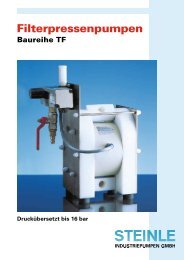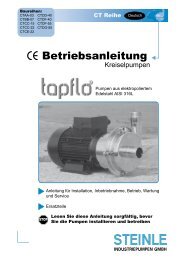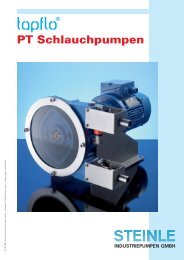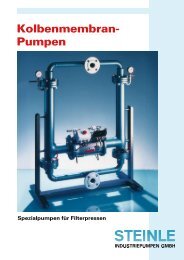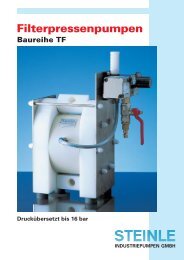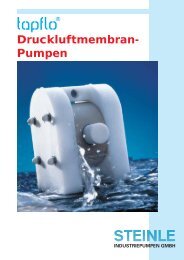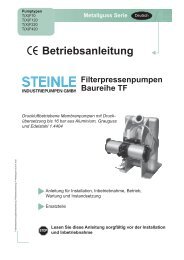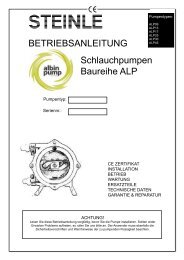EC declaration of conformity
EC declaration of conformity
EC declaration of conformity
Create successful ePaper yourself
Turn your PDF publications into a flip-book with our unique Google optimized e-Paper software.
1. INSTALLATION<br />
1.1 Receiving inspection<br />
Although precaution is taken by us when packing and shipping, we urge you to carefully check the<br />
shipment on receipt. Make sure that all parts and accesories listed on the packing list are accounted<br />
for. Immediately report any damage or shortage to the transport company and to us.<br />
1.2 Storage<br />
If the equipment is to be stored prior to installation, place it in a clean location. Do not remove the<br />
! protective covers from the suction, discharge and air connections which have been fastened to<br />
keep pump internals free <strong>of</strong> debris. Clean the pump thoroughly before installation.<br />
1.3 Foundation<br />
The pump is furnished with vibration absorbing rubber feet. The pump will operate properly without<br />
being fixed to a foundation. If fixation is needed for an installation, make sure the foundation is<br />
! able to absorb vibrations. It is essential for the operation <strong>of</strong> the pump to mount the pump with the<br />
feet in a downward direction (see sketch).<br />
1.4 Suction and discharge pipings<br />
Suction and discharge piping should be fully supported and anchored near to but independent <strong>of</strong><br />
the pump. The piping to the pump should be a hose, to prevent undue stress and strain on the<br />
pump connections and the pipings.<br />
1.4.1 Turnable connections<br />
The suction and discharge connections are turnable 180°. This simplifies the assembling and<br />
installation considerably. If you wish to turn the connections, screw a threaded nipple into the<br />
connection and turn. On the larger models TF200 and TF400 it will simplify if the housing nuts are<br />
slightly released while turning the connections.<br />
1.4.2 Connection <strong>of</strong> suction pipe<br />
Remember that the suction pipe/connection is the most critical point, especially if the pump is<br />
priming. Just a small leakage will dramatically reduce the suction capability <strong>of</strong> the pump. When<br />
connecting the suction pipe, following is recommended.<br />
1) For satisfactory operation, use reinforced hose or corresponding (the suction power may otherwise<br />
shrink the hose). The internal diameter <strong>of</strong> the hose should be the same as on the suction<br />
connection (at the bottom <strong>of</strong> the pump) to have best suction capability.<br />
2) Make sure that the connection hose - pump is completely tight, otherwise the suction capability<br />
will be reduced.<br />
3) Always use as short suction pipe as possible. Avoid air pockets which can arise with long pipings.<br />
1.4.3 Connection <strong>of</strong> discharge pipe<br />
For this connection it is only recommended a simple and positive flow connection. Use a hose or<br />
STOP<br />
flexible piping (minimum one meter) between the discharge connection and any rigid fixed piping.<br />
Coil the hose at least one turn. All components (hose, pipe, valves etc) on the discharge piping<br />
must be designed for minimum PN 16.<br />
1.5 Air connection<br />
Screw the air hose into the air intake on the center block <strong>of</strong> the pump with for example a bayonet<br />
coupling. For best efficiency, use the same hose diameter as the internal diameter <strong>of</strong> the connection<br />
on the air intake.<br />
Instruction manual TF PE & PTFE series pumps 5



